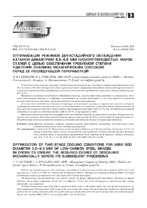| dc.contributor.author | Савинков, В. В. | |
| dc.contributor.author | Ковалева, И. А. | |
| dc.coverage.spatial | Минск | ru |
| dc.date.accessioned | 2018-10-08T07:13:48Z | |
| dc.date.available | 2018-10-08T07:13:48Z | |
| dc.date.issued | 2018 | |
| dc.identifier.citation | Савинков, В. В. Оптимизация режимов двухстадийного охлаждения катанки диаметром 5,5–6,5 мм низкоуглеродистых марок сталей с целью обеспечения требуемой степени удаления окалины механическим способом перед ее последующей переработкой = Optimization of two-stage cooling conditions for wire rod diameter 5.5–6.5 mm of low-carbon steel grades in order to ensure the required degree of descaling mechanically before its subsequent processing / В. В. Савинков, И. А. Ковалева // Литье и металлургия. – 2018. – № 3 (92). – С. 63-66. | ru |
| dc.identifier.uri | https://rep.bntu.by/handle/data/48022 | |
| dc.description.abstract | С целью получения окалины с высокой степенью удаления механическим способом в условиях сортопрокатного цеха
№ 1 на стане «150» ОАО «Белорусский металлургический завод – управляющая компания холдинга «Белорусская металлургическая компании» были разработаны технологические режимы производства катанки из низкоуглеродистых марок стали. Проводили исследования особенности образования окалины, а именно факторов, влияющих на удаляемость, получение оптимальной толщины, и ее фазовых составляющих на катанке диаметром 5,5–6,5 мм в процессе охлаждения непосредственно после прокатки, предназначенной для изготовления проволоки.
Для получения необходимого соотношения фазовых составляющих окалины на поверхности катанки учитывали
температуру раскладки витков на рольганге в линии воздушного охлаждения; плотность витков (равномерность по
длине витка); условия охлаждения спирали витков (предотвращение распада 4FeO = F3O4–Fe), где обязательно должно
соблюдаться условие охлаждения катанки с 600 до 250 °С, не превышающее 100 с. Представлены результаты металлографических исследований окалины на поверхности катанки. Внедренные технологические режимы обеспечили оптимальную толщину и соотношение FeO/Fe3O4 после опытной прокатки металла. Отработанные режимы охлаждения позволили уменьшить расход волок для всех типоразмеров проволоки. | ru |
| dc.language.iso | ru | ru |
| dc.publisher | БНТУ | ru |
| dc.subject | Вюстит | ru |
| dc.subject | Магнетит | ru |
| dc.subject | Гематит | ru |
| dc.subject | Толщина окалины | ru |
| dc.subject | Двухстадийное охлаждение | ru |
| dc.subject | Чистовая клеть | ru |
| dc.subject | Минимальная адгезия | ru |
| dc.subject | Расход волок | ru |
| dc.subject | Типоразмер проволоки | ru |
| dc.subject | Wustite | ru |
| dc.subject | Magnetite | ru |
| dc.subject | Hematite | ru |
| dc.subject | Scale thickness | ru |
| dc.subject | Two-stage cooling | ru |
| dc.subject | Finishing stand | ru |
| dc.subject | Minimum adhesion | ru |
| dc.subject | Fiber consumption | ru |
| dc.subject | Wire size | ru |
| dc.title | Оптимизация режимов двухстадийного охлаждения катанки диаметром 5,5–6,5 мм низкоуглеродистых марок сталей с целью обеспечения требуемой степени удаления окалины механическим способом перед ее последующей переработкой | ru |
| dc.title.alternative | Optimization of two-stage cooling conditions for wire rod diameter 5.5–6.5 mm of low-carbon steel grades in order to ensure the required degree of descaling mechanically before its subsequent processing | ru |
| dc.type | Article | ru |
| dc.identifier.doi | 10.21122/1683-6065-2018-92-3-63-66 | |
| local.description.annotation | With the aim of obtaining scale with a high degree possibility of mechanical removal under the conditions of the section rolling shop No. 1, at the mill «150» JSC «Belarusian Metallurgical Works – Management Company of Holding «BMC» developed technological modes of production of wire rods made of low-carbon steel grades. The peculiarities of scale formation were studied, namely, the factors influencing the removability, obtaining the optimal thickness and its phase components on the wire rod diameter 5.5–6.5 mm in the cooling process immediately after rolling, intended for wire production. To obtain the necessary ratio of the phase constituents of the scales on the surface of the wire rod, the following factors was taken into account: the temperature of the layout of the turns on the roller table in the air cooling line; (uniformity along the length of the turn), the cooling conditions of the helix of the turns (prevention of the 4FeO = F3O4-Fe decay), where the condition of cooling the wire rod from 600 to 250 °С, not exceeding 100 s, must be observed. The results of metallographic studies of scale on the wire surface are presented. The introduced technological regimes
provided the optimal thickness and the FeO / Fe3O4 ratio after the experimental rolling of the metal. Exhausted cooling regimes allowed to reduce the consumption of fiber for all types of wire. | ru |

